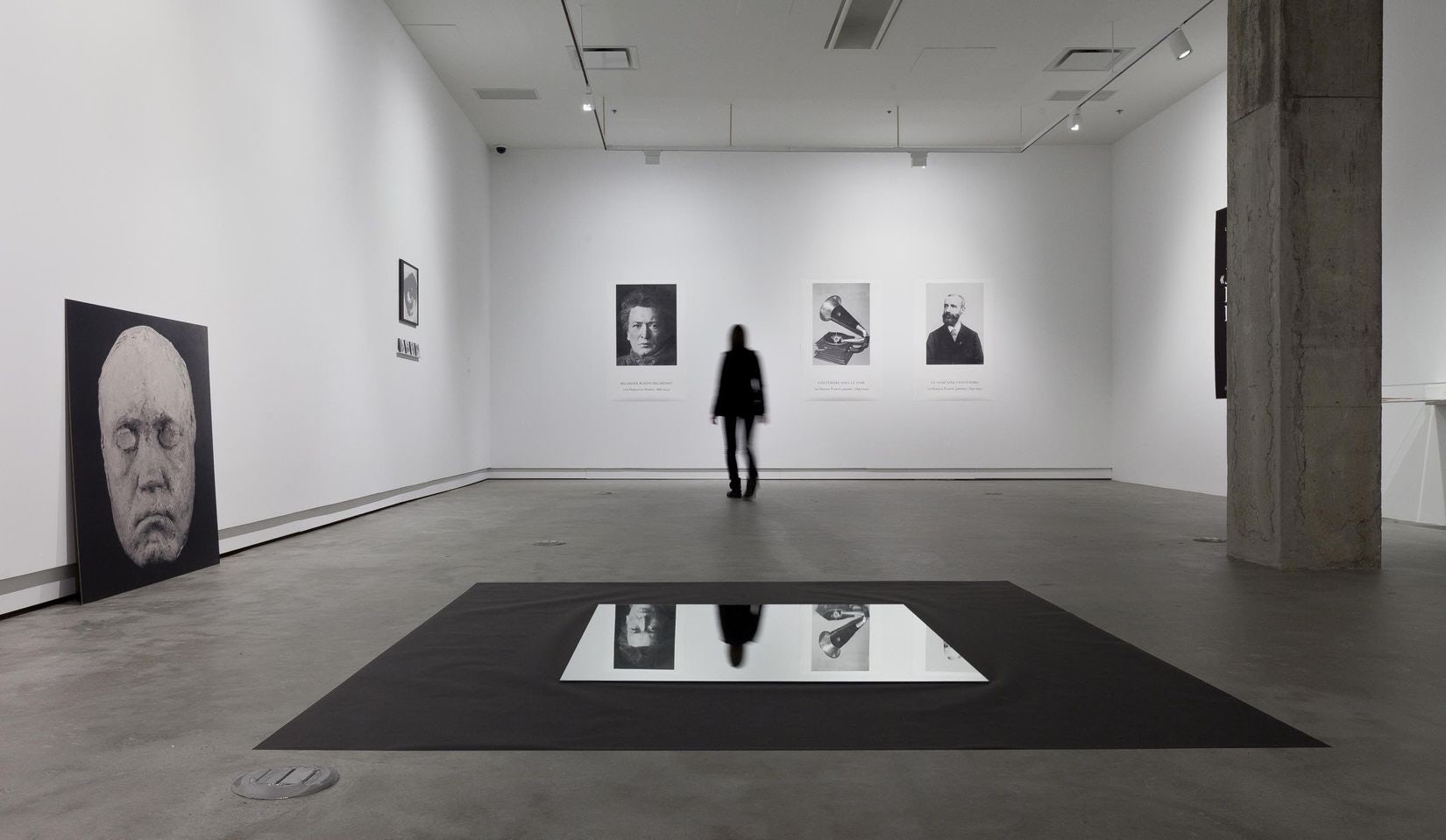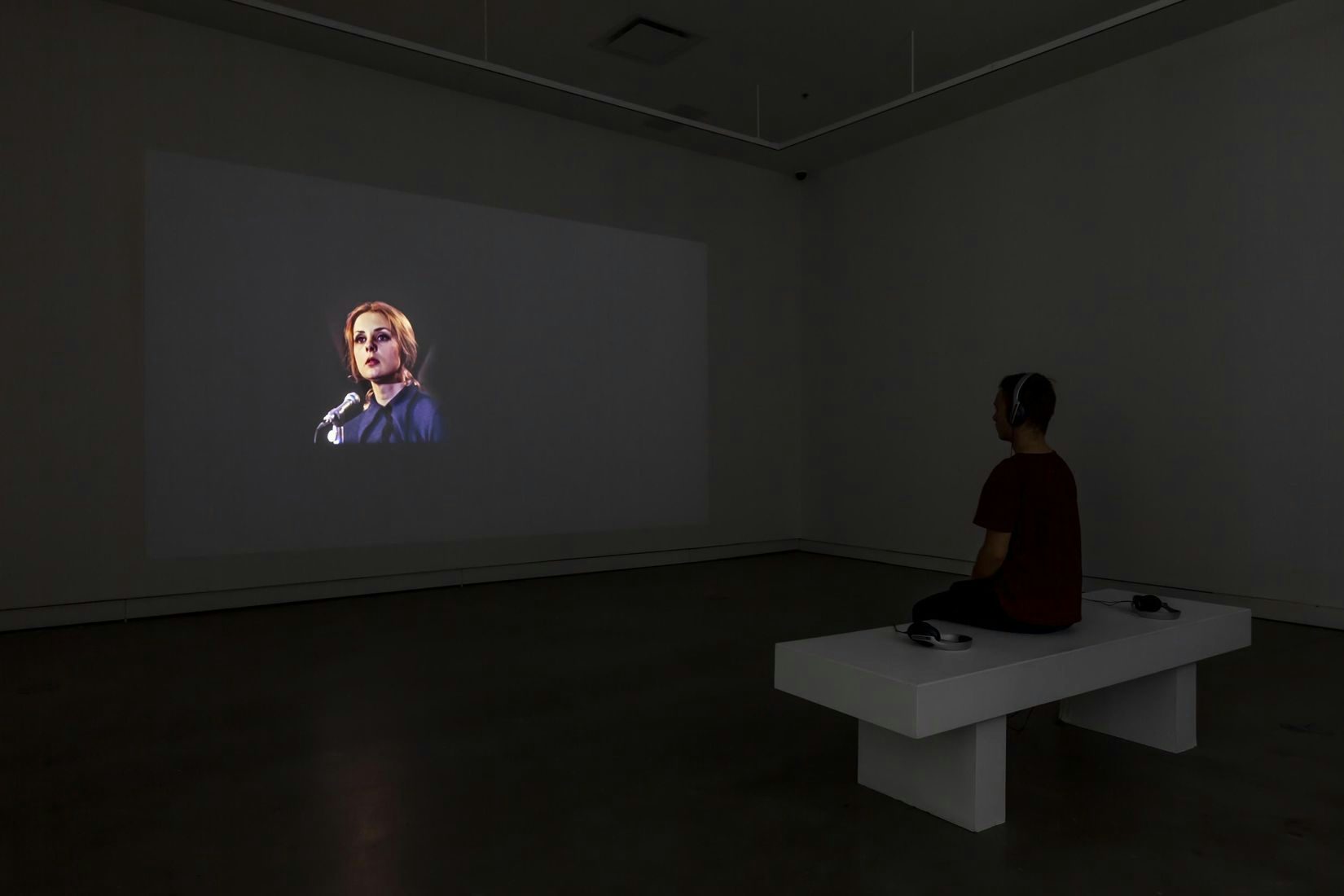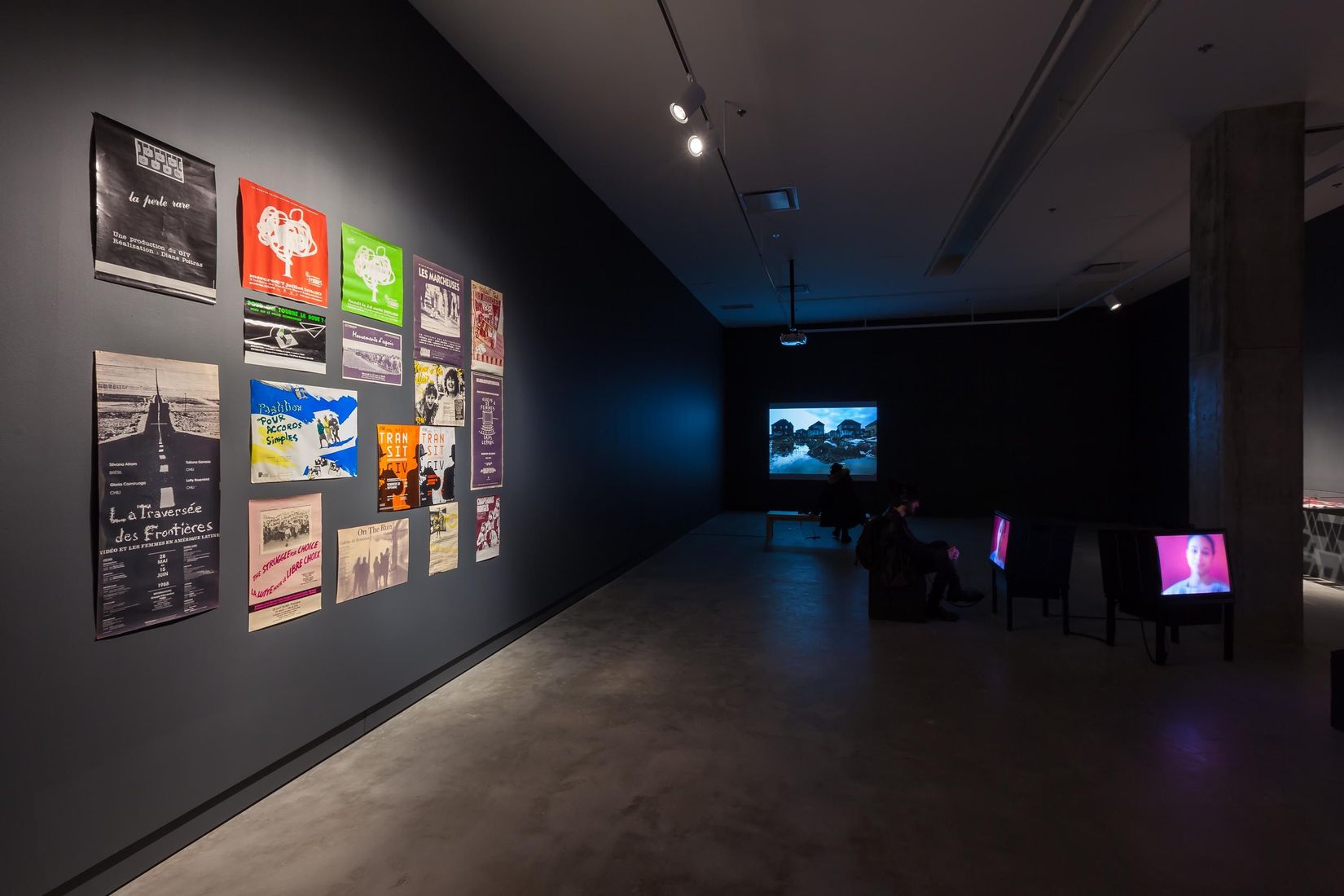
Alexandre Larose
Chutes
2024.09.06 – 12.07
Inner Views
NICOLE GINGRAS
The exhibition Chutes is built around a previously unseen work by Alexandre Larose, La Grande Dame1 (2018–2022), which he first began thinking about in 2005. This four-screen video installation with audio materializes a process of research and experimentation around an iconic Montréal site, Place Ville Marie, associated with a recurring dream of the artist’s. With La Grande Dame, Larose shares a highly personal fascination and conveys to the audience a sensation that has inhabited him for years: that of a body–his body–in free fall, facing skyward.

This quite spectacular installation is complemented by traces of some of the steps in its creation (drawings, visual documentation of film shoots, still images) and a short film, bonne nuit2 (2006). This startling animated film, which I discovered during my research for this major project,3 presages Larose’s attraction to heights, architecture, pulsations of light, and movement.
Origin
Inspired by a dream in which Larose plummets from the top of a building, La Grande Dame evokes a troubling state–between taking off and plunging down–supplemented by sensations of weightlessness, floating, vertigo, disorientation and gravitation. As Larose explains:
“In Québec City, in 2005, I undertook an artistic process aiming to explore the visual and emotional intensity of my dream. Simply put, I created long takes, throwing cameras from the roofs of increasingly higher buildings to capture the point of view of the fall. Creating that point of view without using animation or CGI meant confronting a series of challenges related to live-action shooting. The strategies and technical means that I deployed at each phase of the project informed the images that I created. The structuring concept–the fall–thus catalyzed a whole array of explorations dependent on constantly evolving technological processes. By granting the camera that independence, I transposed the subjectivity of my gaze to a dispositif that acquired its own vision and produced a recording of it. My work then involved reappropriating that vision for myself.”
The installation involves a very short span of time explored repeatedly as an artistic process (for the unusual visual perspectives captured by a camera), i.e., as the subject of observations of a phenomenon associated with gravitational attraction and extending to its multiple connotations: existential, material, scientific, symbolic and oneiric. The artist astutely describes the importance of points of view to the work:
“La Grande Dame emerged from a series of moving images recorded from the top of Place Ville Marie, in Montréal, between 2011 and 2015. To complete the final phase of the project, I recorded several fall sequences, mostly on digital video, using enough cameras to capture a hemispherical field of view, pointing skyward. That point of view is spatialized as a video projection onto four screen surfaces.”
Part dreamer, part observer, part systematic scientist, Larose offers us the experience of a unique event, associated with the duration of a fall lived and recorded by a camera. In reality, quite a few falls and cameras were required to approach the expected result. In this way, multiple temporalities are summoned: various forms of anticipation, the present of a specific action to release a strange projectile (the launcher, which resembles a miniature rocket) and the present of the fall filmed in real time, which terminates in violent contact with the ground. Each fall is unique and unpredictable. Each fall has its own materiality–its movement.
Invention
Although it is different in a formal sense and in the aesthetic choices favoured by the artist (here I mean the choice of medium: digital rather than analog recording, and multiscreen projection), La Grande Dame hinges on a fundamental facet of all of Alexandre Larose’s work: the notion of place. The artist/filmmaker’s entire practice is grounded in observation of spaces in different lights and seasons, and sometimes over a period of years. Larose has developed a profound connection to singular places to which he enjoys returning to film. His attention is drawn to a particular quality of light, a phenomenon, a sensation, an emotion: an event. Because, by definition, a place leads to discovery.
To capture the genius loci of each place he visits and revisits, Larose–being sensitive to changes in light as the hours pass, attentive to a particular landscape or specific architectural elements (window, door, staircase, threshold)–introduces a presence. One or sometimes two ghostly silhouettes are seen, like fleeting apparitions, animating, as it were, the filmed shot and inhabiting it, if only momentarily. These evanescent presences then dissolve, as they are traversed by light and filmed in motion, using a technique specific to the filmmaker. It is notable that while shooting his films, Larose choreographs each shot, which allows him to produce images rich in superimpositions and internal modulations. He shoots without looking through the camera viewfinder, after carefully choosing the framing. A fascinating approach. As if the desired, expected image needs to imprint itself on the film without the artist’s knowledge. Only after the film is developed–often weeks or even months later–does he see what he has filmed.
Alexandre Larose works at length, with vigilance, on each project, each piece. He takes his time. These are not cycles in the strict sense, nor series, but rather processes of research involving precisely defined aspects of the image–its presence or prevalence in movement, as well as its appearances and disappearances in light–and of space. One production or experimentation leads to another, different each time. The processes and dispositifs that the artist develops are essential. They reveal a certain rigour in conception, yet are not a form of control. And, inevitably, that precision co-exists with the unforeseen and negotiates with the unexpected or the accidental:
“In my work in general, both in the images I create and the processes I develop, there is an attempted confrontation with technology. To expand my gaze, I tend to engage with cinematic tools and devices that subordinate me to their mechanisms. For La Grande Dame, I transposed that duel to the filmed subject: the staging of an individual face to face with the modern skyscraper architecture, a space that is often viewed as alienating to humans. The vision recorded by the camera becomes, in a way, the fruit of the temporary union between my artistic intent and the primitive gaze of a machine on which I impose a trajectory. It is therefore through the filmed material, its treatment and its presentation that I have succeeded in embracing the experience of this fall.”
For La Grande Dame, which was anything but a transient project, Larose developed a shooting protocol completely different from that previously mastered for his 16mm and 35mm films, but without forgoing the performative aspect of filming so characteristic of his practice. For obvious reasons, the chosen technique is the launching of a camera from the top of a skyscraper. The image of a performance executed by a camera is the necessary outcome. The fall becomes the main character of the work. And if there is a systematic approach involved in this work, it is in the repeated launchings of cameras from the tops of various tall buildings, over a span of several years, weather conditions permitting.
Presence
Seldom in Larose’s films do we perceive his own presence in the image. La Grande Dame is certainly the most public piece he has created to date. For the artist has exposed himself to various degrees: he worked and filmed in a public space, in an urban setting; he is visible almost every time the camera is thrown. And he competes with the main “characters” in the installation: the Place Ville Marie tower, the fall and, clearly, the camera. And yet, thinking about this piece, I find it hard to speak in terms of intimacy–of that quality of precarious presence that informs all of his filmed work. But I do see in it a singular fragility: La Grande Dame holds secret stores that we are invited to glimpse in this place that the artist has designed especially for our gaze.
While Alexandre Larose is appreciated for his vision and the materiality of his films screened in theatres, opportunities to view his installations in Montréal are surprisingly rare. The presentation of La Grande Dame, the central focus of the exhibition Chutes, is therefore an important milestone and anchor point in the artist’s career. It may seem strange to speak of an anchor point with an artist/filmmaker who is so fascinated by movement, mobility and the dissolution of shapes, manifestations of immateriality–in other words, by the atomizing of an instant. But paradox is the fuel for creation and discovery.
The artist and curator wish to thank the Conseil des arts et des lettres du Québec for its support for the exhibition’s research and presentation at VOX, centre de l’image contemporaine and for the cycle of projections Alexandre Larose – Portraits at the Cinémathèque québécoise.



